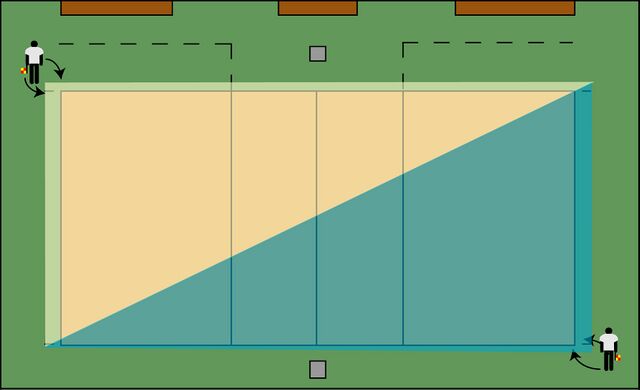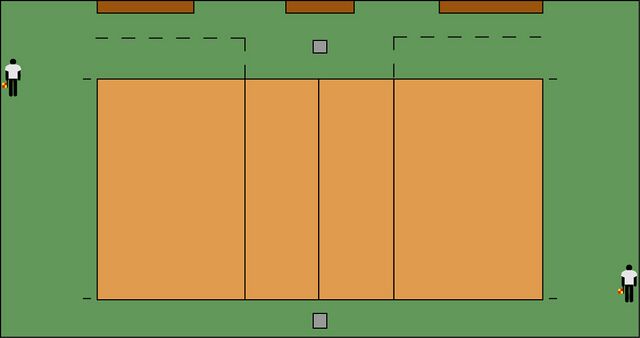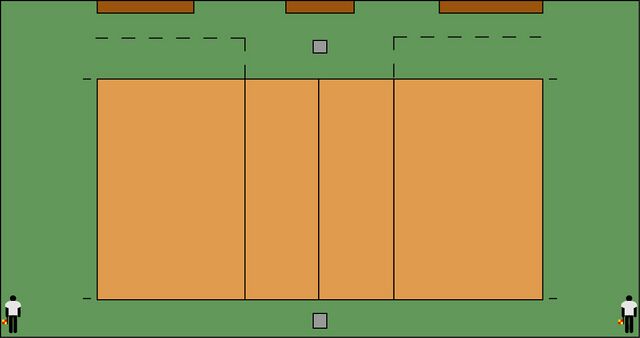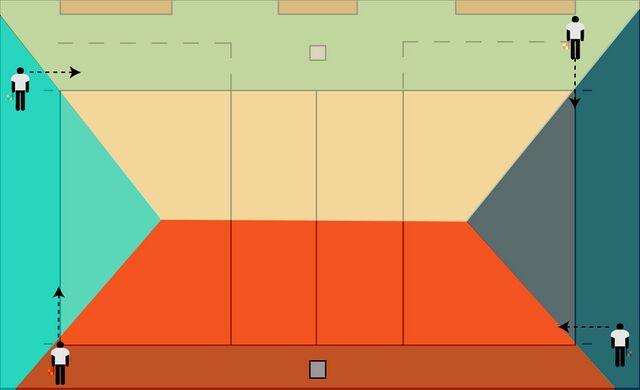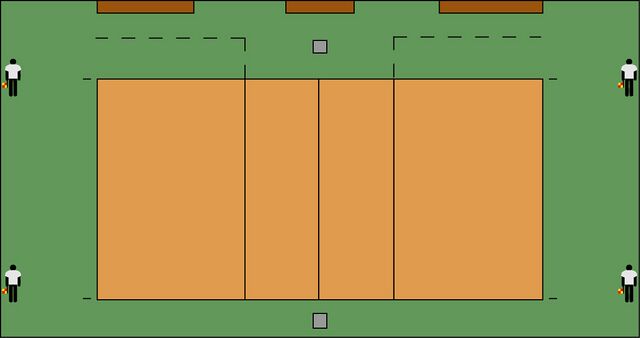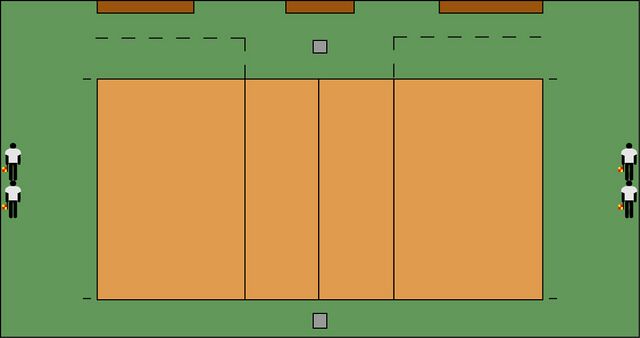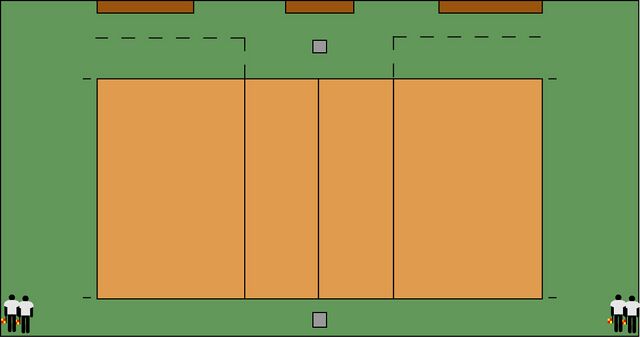4.4 Line judges
| [unchecked revision] | [unchecked revision] |
imported>Gesc m (Gesc moved page Line-judges to Line judges) |
imported>Gesc No edit summary |
||
| Line 12: | Line 12: | ||
[[File:lr_2zone.jpg|640px|link=File:lr_2zone.jpg]] | [[File:lr_2zone.jpg|640px|link=File:lr_2zone.jpg]] | ||
</loop_figure> | </loop_figure> | ||
In the 2-line-judge-system, the line-judges are located at positions 1 and 3 and must observe one long and one short line and the corresponding antenna and make appropriate decisions. The | In the 2-line-judge-system, the line-judges are located at positions 1 and 3 and must observe one long and one short line and the corresponding antenna and make appropriate decisions. The line judges should take up a position about 1 to 2 metres from the corner. Depending on the game situation, they should change their position in the alignment of the lines. | ||
<hr /> | <hr /> | ||
=== | === Positions during intervals - 2 line judges === | ||
<loop_figure title="2- | <loop_figure title="2-line judge system - Positions in time-outs"> | ||
[[File:lr_2-teamto.jpg|640px|link=File:lr_2-teamto.jpg]] | [[File:lr_2-teamto.jpg|640px|link=File:lr_2-teamto.jpg]] | ||
</loop_figure> | </loop_figure> | ||
In | In team time-outs the line judges go to the board in the extension of their long line. | ||
<hr /> | <hr /> | ||
<br /> | <br /> | ||
<loop_figure title="2- | <loop_figure title="2-line judge system - positions in set intervals"> | ||
[[File:lr_2-satzpause.jpg|640px|link=File:lr_2-satzpause.jpg]] | [[File:lr_2-satzpause.jpg|640px|link=File:lr_2-satzpause.jpg]] | ||
</loop_figure> | </loop_figure> | ||
In | In set intervals, the line judges go to one of the corners, each on his half of the court. | ||
<br /><br /> | <br /><br /> | ||
<hr /> | <hr /> | ||
Revision as of 09:18, 16 January 2020
Allgemeines
A distinction is made between the 2- and 4-line judge system. The positions of the line judges are named 1 to 4 counterclockwise, starting at the first referee. While in the 4-line-judge-system all positions are taken, in the 2-line-judge-system only positions 1 and 3, but here named 1 and 2, are taken.
2-line-judge-system
In the 2-line-judge-system, the line-judges are located at positions 1 and 3 and must observe one long and one short line and the corresponding antenna and make appropriate decisions. The line judges should take up a position about 1 to 2 metres from the corner. Depending on the game situation, they should change their position in the alignment of the lines.
Positions during intervals - 2 line judges
In team time-outs the line judges go to the board in the extension of their long line.
In set intervals, the line judges go to one of the corners, each on his half of the court.
4-Linenrichter-System
Beim 4-Linienrichter-System befinden sich die Linienrichter an allen Ecken des Spielfelds. Sie müssen jeweils eine lange bzw. eine kurze Linie beobachten und dementsprechende Entscheidungen treffen. Die Linienrichter sollten eine Position in ca. 2 bis 3 Meter Entfernung zur ihrer Linie einnehmen.
Positionen in Spielunterbrechungen - 4 Linienrichter
In Team-Time-Outs gehen die Linienrichter in der Verlängerung ihrer langen Linie an die Bande.
In technischen Time-Outs begeben sich die Linienrichter in der Mitte der jeweiligen Servicezone an die Bande.
In Satzpausen begeben sich die Linienrichter in eine der Ecken, jeweils auf ihrer Spielfeldhälfte.
Aufgaben
Linienrichter signalisieren dem Schiedsrichter:
- In, Out und Touch
- Bälle, die externe Objekte berühren (Antenne, Decke, Schiedsrichterstuhl, Netzpfosten, Spannseile...)
- Fußfehler des Servicespielers
- Bälle, die die gedachte Verlängerung der Mittellinie außerhalb der Antenne überqueren
- Spieler, die zum Zeitpunkt des Service (teilweise) außerhalb des Spielfeldes stehen
- Spieler, die die oberen 80 cm der Antenne in ihrer Ballspielaktion berühren
Linienrichter-Signale
Die Linienrichter Signale findest du im Abschnitt Handzeichen.
Texts and pictures are published under:
![]()
Videos are published under:
![]()

